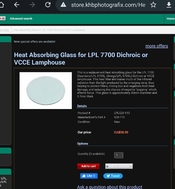The only other thing I can think of is to try a lamp specifically designed for use in an LPL enlarger, if there isn't already one installed. I can't recall whether there was something out of the ordinary about the bulb in mine.
Edit: I lied, I thought of another possibility: If voltage is running higher than expected, I'd expect the lamp's color temperature to rise, and hence, it's spectrum to shift more towards blue. If you have the means to do so, try measuring to ensure that voltage with lamp installed really is 12 volts or close to it.
By the way, what are your typical paper exposure times?





 . Not trying tonight, but if it works I'll let you know.
. Not trying tonight, but if it works I'll let you know.


